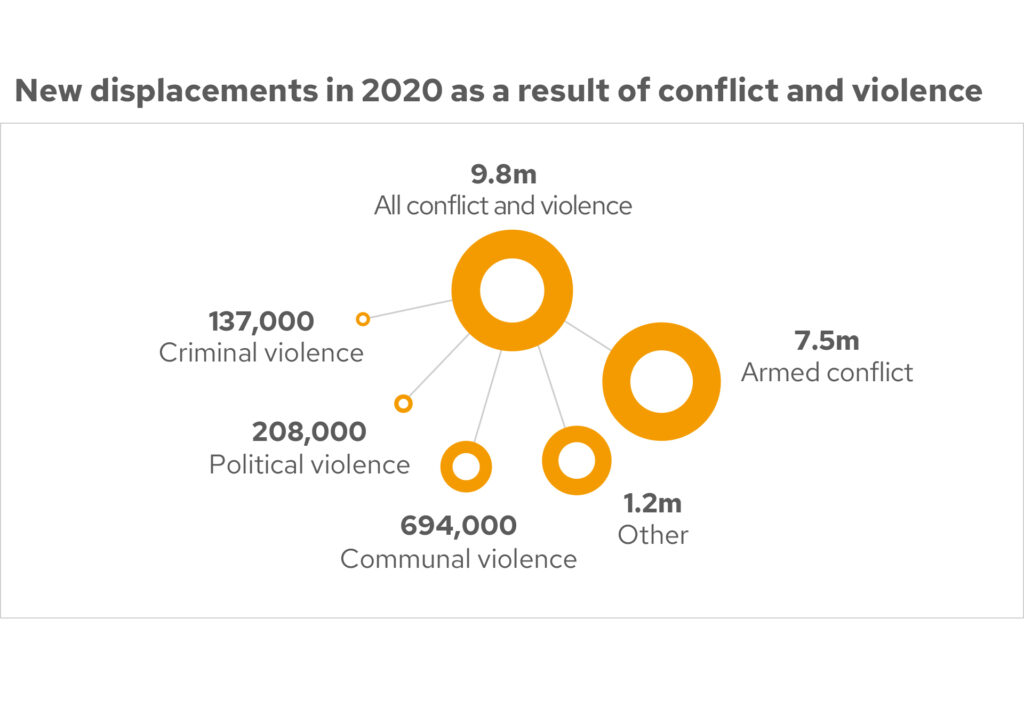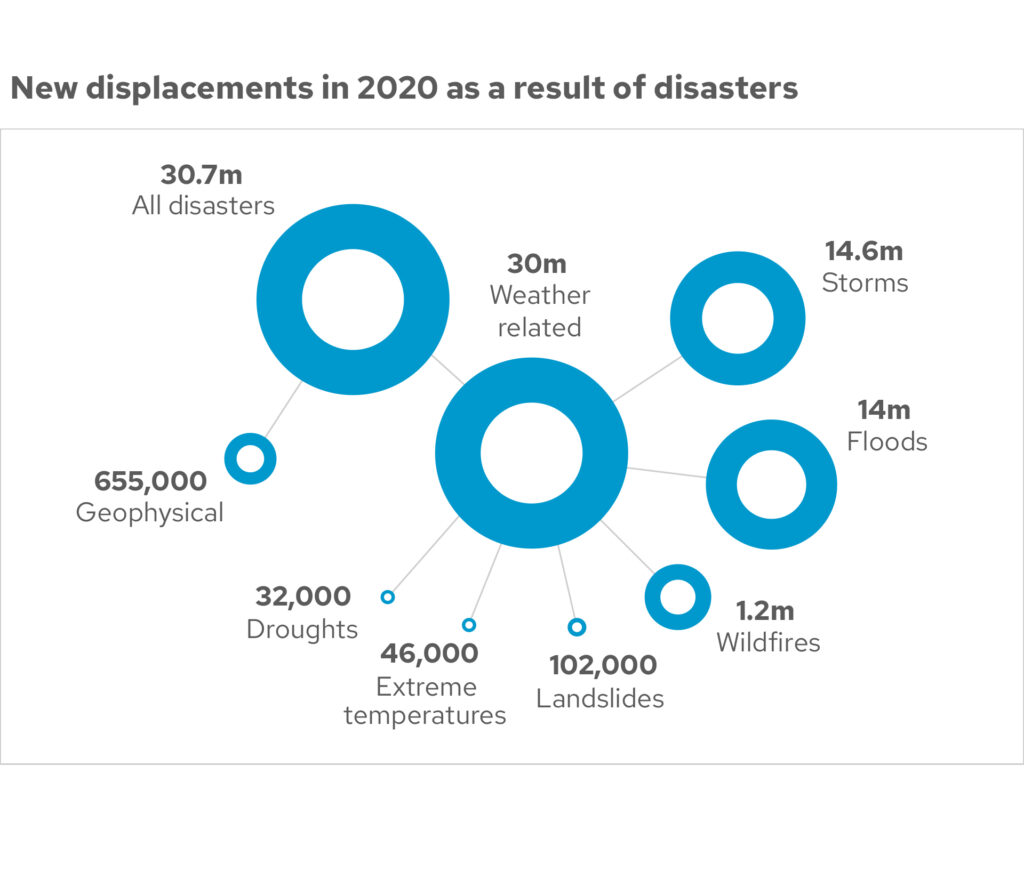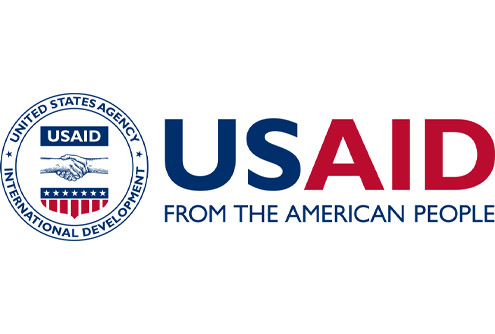FORCED DISPLACEMENT
Introduction and methodology
Introduction
Forced displacement is on the rise and a driver of disaster risk. In 2020, conflict and disasters triggered 40.5 million new internal displacements across 149 countries and territories.
This led to a total of 55 million internally displaced people across the world. 9.8 million were internally displaced by conflict and violence, and 30.7 million as a result of disaster – the highest figures coming from storms (14.6m), floods (14m) and cyclones, hurricanes and typhoons (13.6m). It is estimated that 26.3 million people are refugees.

Average displacement is 20 years
Knowing that the average length of displacement is twenty years, protracted displacement has become common. Rather than safe and controlled evacuation and resettlement, up to one in four displaced persons end up in informal settlements, often on the edge of cities and urban areas. Whilst cities can be places of opportunity, new arrivals can also face isolation, cultural difference and exclusion. It is critical that not only the short-term needs of displaced persons are met but also factors of their reality are understood to ensure durable solutions and long-term resilience are built.

A driver of risk
Forced displacement is seen as a disaster risk driver by GNDR. Those who are at risk of displacement or already displaced face a significantly increased probability of protection, wellbeing and resilience vulnerabilities. They are more vulnerable to hazards and other risks or threats than those able to stay in their chosen place of residence, and they also face incredible difficulties in strengthening their resilience.
In order to understand the challenges faced, displaced persons living in informal settlements in urban areas around the world, the civil society organisations (CSOs) supporting them and local government representatives responsible for their welfare shared their perspectives. Views from the Frontline (VFL) methodology, as well as other participatory techniques, were used. Perspectives gathered on their risk context and enabling environment have been made to draw findings and conclusions on how forced displacement can be addressed.
Methodology
Through our Making Displacement Safer programme, 11 displaced communities in urban areas have been selected for local research, action and influence. The research from these 11 displaced communities has largely made up the research for this paper.
Over 4,900 displaced persons were interviewed using a version of ‘Views from the Frontline’ (VFL) methodology. This is an assessment tool that aims to understand the threats, consequences, actions and barriers of displaced populations in urban areas to understand their challenges and perspectives.
Having selected an urban area hosting displaced persons, participatory mapping processes were undertaken to further understand the urban area, communities, hazards, vulnerabilities, stakeholders and service provision within it. The urban area was divided into subdivisions, and from this an equitable number of houses selected per sub-division to contribute to the survey (one person per household). Total participation in VFL was to be made up by 30% men, 30% women, 20% children and youth, 10% people living with disabilities and 10% older persons. Furthermore, five representatives of local CSOs and five representatives of the local government were invited to participate.
The total sample size was based on 10% of the total number of displaced persons within that urban area. This figure was then adjusted considering how that related to the global target population of 4,800 to be involved. For example, if the figure was too high to be able to deliver within time and budget or too low to be an equitable contribution to reach 4,800 globally then calculations were made to present a more equitable figure across the 11 urban areas.
Causes of displacement
For the purposes of VFL, the main causes of displacement were defined as:
- Social hazards including, but not limited to, domestic violence, political tension or division and discrimination
- Disasters or natural hazards including, but not limited to, aspects such as floods, extreme weather events, earthquakes, etc.
- Conflict including, but not limited to, violence, war, rioting and terrorist attacks.
- Economic including, but not limited to, poverty and having to seek work elsewhere
- Other
Stakeholder mapping, hazard mapping, story analysis, policy analysis and focus group discussions were also held within these urban displaced communities. To complement this, 185 stories from GNDR members around the world were analysed and a roundtable discussion of 52 stakeholders from academia, civil society, UN agencies and international organisations reviewed and confirmed the findings and conclusions of the research.
Global Finding 1: Prolonged vulnerability
Next chapterForced Displacement Global Paper
ContentsCredits
Photo (top and above): A Syrian refugee family in the Azraq camp, northern Jordan. Credit: Russell Watkins/DFID.
Photo (middle): A view inside the Zaatari camp, northern Jordan. Credit: Russell Watkins/DFID.
Graphics: Global Report on Internal Displacement 2021, Internal Displacement Monitoring Centre (IDMC). Due to rounding, some totals may not correspond with the sum of separate figures.
Project funded by
United States Agency for International Development

Our Making Displacement Safer project is made possible by the support of the American People through the United States Agency for International Development (USAID) – Bureau for Humanitarian Assistance. Content related to this project on our website was made possible by the support of the USAID. All content is the sole responsibility of GNDR and does not necessarily reflect the views of the USAID.
Become a member
Membership is free and open to all civil society organisations that work in disaster risk reduction or have an interest in strengthening the resilience of communities.
Join GNDR